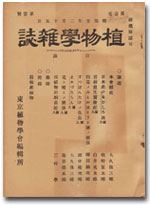All issues

Volume 75, Issue 892
Displaying 1-5 of 5 articles from this issue
- |<
- <
- 1
- >
- >|
-
Yozo IWANAMI1962 Volume 75 Issue 892 Pages 371-376
Published: 1962
Released on J-STAGE: December 05, 2006
JOURNAL FREE ACCESSStudies were made of the cross and vertical sections of Portulaca filament.
Portulaca filament is made from 3 parts, namely epidermis, parenchyma and vascular bundle. Epidermis is a layer of large cells (dimentions-10×30×100μ3) arranged side by side. In the parenchyma there are many intercellular spaces which have gaseous substances. Vascular bundle consists of xylem and pholoem.
The stracture of the Portulaca olelacea filament is almost similar to that of the Portulaca grandiflora.
When the freezing preparation is defrozen, it is observed that the membrane of epidermal cells bends inward at a papilla. The author thinks that the membrane of epidermal cells has a tendency to contract such like and this contractibility of the membrane has some kind of relation to the movement of Portulaca stamen.View full abstractDownload PDF (1627K) -
Tuguo TATEOKA1962 Volume 75 Issue 892 Pages 377-383
Published: 1962
Released on J-STAGE: December 05, 2006
JOURNAL FREE ACCESS1. Starch grains of endosperm of 766 grass species belonging to 244 genera have been examined. The starch grains are divided into four types. Type 1 represents simple grains which are broadly elliptic, elliptic-round, or rarely reniform. Starch grains of Type 2 are also simple, but they are hexagonal, pentagonal, round, or rarely rectangular. In Type 3, both simple and compound grains are included in the same seed. In Type 4, only compound grains are found throughout the endosperm.
2. Type 1 is found only in Triticeae, Bromus and Brachypodium. Type 2 is observed in most species of Panicoideae, some members of Eragrostoideae, Arundinoideae and Bambusoideae and Brachyelytrum of Festucoideae. Some species of Panicoideae, Eragrostoideae and Arundinoideae have shown Type 3. Type 4 is most common in grasses, and is found in many species of Festucoideae, Eragrostoideae and Oryzoideae, and in some species of Panicoideae, Arundinoideae, and Bambusoideae.
3. Systematic significance of starch grains has been discussed. The differences between Types 2, 3 and 4 may be of minor value, as all of these types are sometimes found in species of the same genus. The difference between Type 1 and Type 4 seems to be systematically significant. According to the habitual division of the starch grains of grass endosperm into two types, simple and compound, the starch features can not be rightly used in the systematics.View full abstractDownload PDF (1053K) -
Taeko SATO1962 Volume 75 Issue 892 Pages 384-390
Published: 1962
Released on J-STAGE: December 05, 2006
JOURNAL FREE ACCESS1) The protoplasmic streaming in the stalk of Acetabularia calyculus was influenced markedly by changes in the concentration of K, Ca, and Mg ions in the external medium (sea water).
2) The optimum concentration of K for the streaming was found to be around 0.01M. The rate of flow decreased at higher as well as lower concentrations.
3) An additional amount of Ca ion in the external medium increased the rate of streaming, whereas subnormal Ca concentration retarded the streaming.
4) Contrary to Ca, higher concentration of Mg ion caused a decrease in the rate of flow, while lowering the Mg concentration below the normal level accelerated the streaming.
5) It was found that Ca and Mg ions exert exactly opposite effects on morphological changes of the cytoplasm as they did on the rate of streaming.View full abstractDownload PDF (1343K) -
Experimental ResearchShigezo MURATA1962 Volume 75 Issue 892 Pages 391-400
Published: 1962
Released on J-STAGE: December 05, 2006
JOURNAL FREE ACCESS -
The Karyotype Analysis in Tribe SenecioneaeHisao ARANO1962 Volume 75 Issue 892 Pages 401-410
Published: 1962
Released on J-STAGE: December 05, 2006
JOURNAL FREE ACCESS1. The somatic chromosome numbers and the karyotypes were studied in nine species and subspecies belonging to subfamily Carduoideae.
2. The numbers of somatic chromosomes were counted in five species of Senecio, two species of Ligularia and two species of Farfugium for the first time.
3. All the members of Senecio studied have, in general, symmetrical karyotypes suggesting to be phylogenically primitive. Senecio cannabifolius has a characteristic symmetrical karyotype which resulted from high polyploidization of the basic number of 5 or 10.
4. On the basis of the karyological data obtained, the taxonomic positions of Farfugium japonicum and F. hiberniflorum were considered.
5. Ligularia and Farfugium species have the same chromosome number of 2n=60, but are karyologically different. And Farfugium species has a karyotype more asymmetrical than that of Ligularia.View full abstractDownload PDF (1705K)
- |<
- <
- 1
- >
- >|